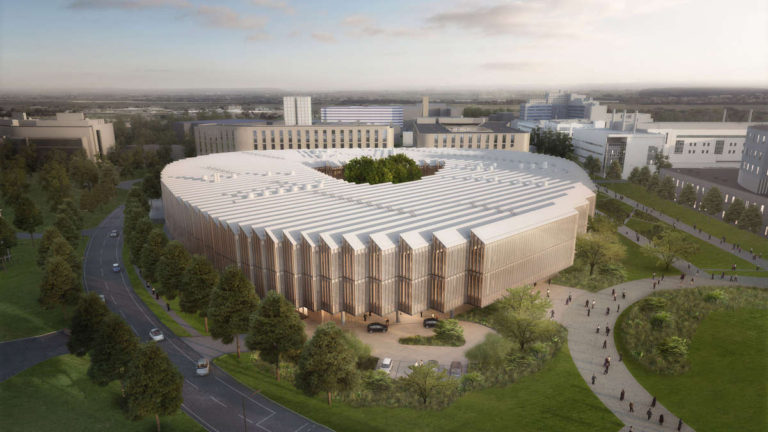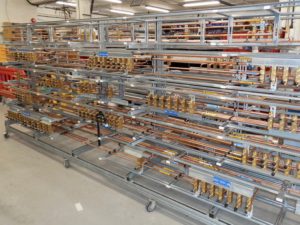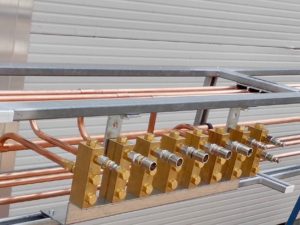CASE STUDY : ASTRA ZENECA
High integrity distribution systems for AstraZeneca’s ground breaking biomedical facility
We have provided AstraZeneca Research and Development Centre, Cambridge with the high integrity distribution systems required for its mission to discover and deliver biopharmaceutical products to improve the lives of people with respiratory, cardiovascular, renal and metabolic conditions and cancer as part of an £8.5 million contract.
Background
AstraZeneca is at the forefront of science in Britain, innovating in medicines to improve the lives of people with respiratory, cardiovascular, renal and metabolic conditions and cancer. Seeking to add biopharmaceutical products that will make ‘a meaningful difference to people’s lives’ to the portfolio of over 40 products which it currently manufactures and supplies to 130 markets worldwide.
AstraZeneca’s £500 million-plus global headquarters and research and development centre on Cambridge Biomedical Campus represents a major leap towards the company’s ambition to foster a collaborative culture and provoke innovation. Its innovative open design and location at the heart Campus – near to Addenbrooke’s, the new Royal Papworth Hospital and to external collaborators such as the MRC Laboratory of Molecular Biology, the Cancer Research UK Cambridge Institute and University of Cambridge research institutions – specifically intended to facilitate this.
We are unique in our ability to deliver both purified water and laboratory gas delivery systems to this scale of project. As the recognised market leader in our field, we were selected to deliver turnkey high integrity distribution systems for both these and for liquid nitrogen, super critical fluid (SCF), clean steam, solvent delivery and waste collection plus a hydrogenation suite.
Every one of the systems in this project is potentially dangerous if not designed and installed with close attention to detail – we are dealing with high temperatures, high pressures, asphyxiants, flammable and volatile elements.
Robert Smith, Sales and Commercial Director
The project
T0 design, manufacture, co-ordinate, supply, install, test and commission turnkey high integrity distribution systems:
- Laboratory gases, including compressed air, vacuum and anaesthetic gas scavenging
- Purified water
- Hydrogenation
- Liquid nitrogen
- Solvent systems
- SCF
- Clean steam
Innovative laboratory gas delivery system for flexi labs
The innovative laboratory gas delivery systems we have designed for the AstraZeneca Research and Development Centre, which comprises over 75,000 metres of pipework and more than 3000 outlets, makes flexi lab working a reality. The copper pipes supplying the gases have outlets in the laboratories which connect to special flexible hoses, providing those using the laboratory with the option to reconfigure the layout of it and still safely deliver the gases required to wherever they are needed, or to add additional lines. Although this is a high specification specialist system this innovative approach means that modifications can be carried out by on-site maintenance with no compromise to the system’s integrity and without specialist intervention. The couplings between the hoses and taps are specific to the gas to be supplied to avoid cross contamination and the various threats to health and safety that may result from this.
Maintaining a supply of purified water and clean steam
Purified water for the laboratories at AstraZeneca Research and Development Centre is generated using a Puretech OASYS pharmaceutical water system. Water direct from the mains (at approximately 200-1000 millisiemens per centimetre) is softened then passed through reverse osmosis (RO), which removes about 95% of microbes, particulates,, minerals etc. Electrodeionisation (EDI) then removes the remaining ions, leaving H2O with a purity of circa 0.1 mS/cm. This is stored in a 5000-litre tank and then pumped around a stainless-steel ring main to the various user points in the laboratories, ensuring a constant supply of purified water.
The OASYS provides purified water for the Centre’s plant and clean steam system. Purified water is evaporated in a pure steam generator and piped to the laboratories where it is primarily used for sterilisation.
As with all our systems, the pipework for the purified water and the clean steam systems at the Centre is stainless-steel and orbitally welded to give the cleanest surface possible internally and externally and to ensure the maximum possible integrity to the joints. An argon purge of the system is used to prevent oxidisation internally and a borescope is used to check the system prior to commissioning.
Weld maps describing each weld and how it was inspected, with video evidence if available, are supplied to the client together with details of the welders’ qualifications, procedures used, material certificates and gas certificates. Once completed the we passivate the system to remove any oxidisation.
Ensuring system purity where it matters most – the hydrogenation suite
Hydrogenation is the chemical addition of hydrogen to a hydrocarbon in the presence of a catalyst, a severe form of hydrogen treating. The use of hydrogen requires precautions against creating an explosive mix of hydrogen and air. Typically, a hydrogenation vessel undergoes a pressure test followed by several nitrogen purges before hydrogen is introduced. Similarly, at the end of the reaction process, the vessel is purged with nitrogen in order to leave it in a safe condition.
Very small gauge stainless-steel pipework ( ¼”) delivers hydrogen, compressed CO2 and nitrogen serve the hydrogenation room where it feeds the 2-litre vessels which are at the heart of the hydrogenation process.
Not only is the purity of the installation of this intricate system critical in aesthetic terms, as it is all on show in this state-of-the-art facility, but it is critical because of the potentially catastrophic consequences of any fault, for example, a leak in the hydrogen delivery system.
AstraZeneca’s research facility is purpose built to carry out experiments at the very fore front of biopharmaceuticals, with researchers working with gases at high temperatures and high pressures and potentially in untested scenarios. The risk of this type of work is minimised by working in small scale, but it still exists. The hydrogenation suite design is? ‘explosion smart’, with blast panels designed control where the energy leaves the area should an explosion occur.
Once installed the system is fully tested and commissioned to the highest standards.
Delivering liquid nitrogen safely
To deliver liquid nitrogen, which has an extraordinarily low boiling point of -196C, from the 5000 litre storage tanks at AstraZeneca to the points of use (direct feeds and dewars) around the facility requires a system of insulated pipework. 1.5” stainless-steel pipes run through 3” stainless steel pipes with a vacuum between the two to minimise gas-off. The integrity of the pipework is essential in maintaining the vacuum and the temperature of the nitrogen and in keeping the nitrogen in its liquid form and containing it. Nitrogen is deadly in its gas form, so a leak is potentially disastrous.
Solvent delivery system
The storage of solvents presents a number of health and safety risks as they can be flammable, toxic and corrosive so they are kept in a designated area from which they are pumped to the outlets where they’re needed. AstraZeneca solvent delivery system has three solvent lines, one dedicated to dimethyl sulfoxide (DMSO) and two others.
In addition, the solvent room is supplied with supercritical fluid (SCF or liquid Co2). The liquid Co2 acts like an organic solvent and is delivered from storage tank via orbitally welded insulated stainless-steel pipes. Unlike many organic solvents, supercritical CO2 is non-flammable. It is inert, non-toxic, has a relatively low cost and has moderate critical constants.
Innovation
To make the installation of the gas system as efficient as possible we built an innovative system of pipework cassettes populated with blocks of quick connect points for the flexi hoses. Once on site the cassettes are loaded into modules, with up to 10 pipes on each module carrying gases plus power, chilled water, sprinkler system etc.
Summary
Providing the high integrity delivery systems for ground breaking biomedical facility at AstraZeneca’s Research and Development Centre is a three-year project, which demonstrates the range of our capabilities, our innovative approach and our dedication to delivering systems with zero compromise on integrity or aesthetics, which deliver the gas or liquid they are designed for safely and purely.



